Discover 11 hidden attractions, cool sights, and unusual things to do in Stone Town (Tanzania). Don't miss out on these must-see attractions: House of Wonders, Darajani Market, and Forodhani Gardens. Also, be sure to include Sultan's Palace in your itinerary.
Below, you can find the list of the most amazing places you should visit in Stone Town (Zanzibar West).
Table of Contents
House of Wonders
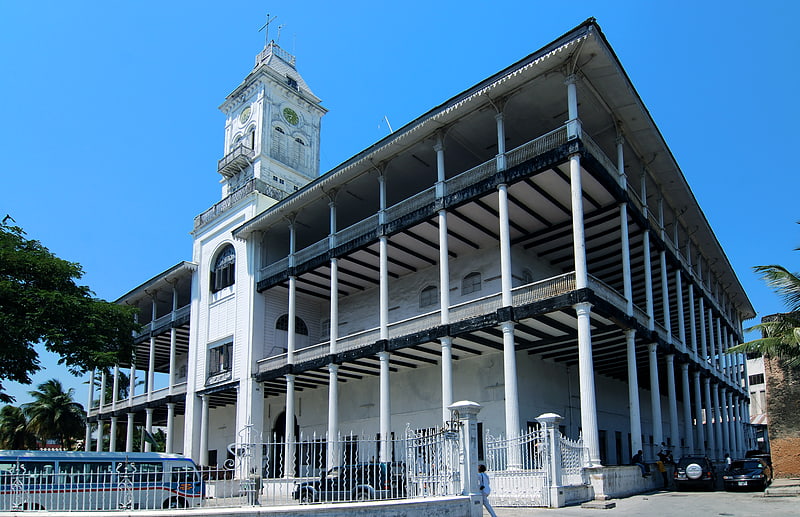
Museum in Zanzibar, Tanzania. The House of Wonders or Palace of Wonders is a landmark building in Stone Town, Zanzibar. It is the largest and tallest building of Stone Town and occupies a prominent place facing the Forodhani Gardens on the old town's seafront in Mizingani Road. It is located between the Old Fort and the Palace Museum. It is one of six palaces built by Barghash bin Said, second Sultan of Zanzibar, and it is said to be located on the site of the 17th-century palace of Zanzibari queen Fatuma. The House of Wonders housed the Museum of History and Culture of Zanzibar and the Swahili Coast.[1]
Address: Mizingani Road on the seafront, Stone Town
Darajani Market
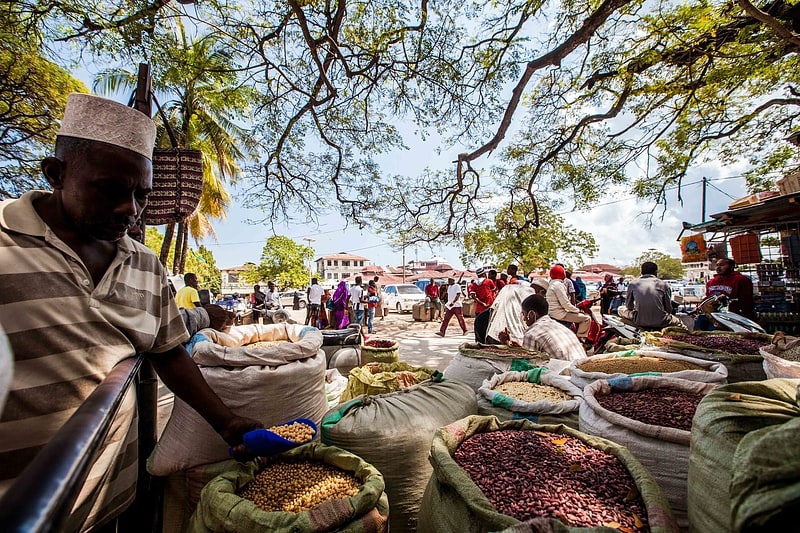
Market in Zanzibar, Tanzania. The Darajani Market is the main bazaar in Stone Town, Zanzibar. It is also known as Estella Market and informally as Marikiti Kuu. The market is located in Darajani Road, in the surroundings of the Anglican Cathedral of Christ.
The main structure of the market was built in 1904 by Bomanjee Maneckjee, for Sultan Ali bin Hamud. It was later extended and restored.
Darajani Bazaar is mainly a food market (seafood, meat, fruits, grains, spices), but there are also shops selling a number of different goods, from consumer electronics to clothing.[2]
Address: Market St, Stone Town
Forodhani Gardens
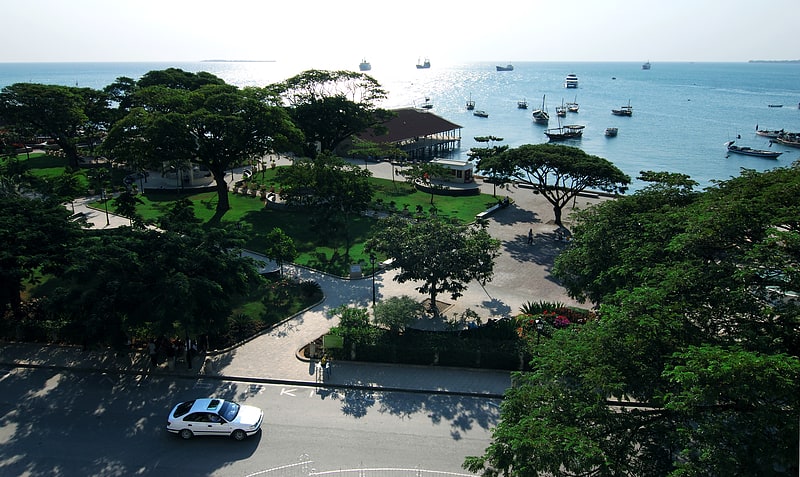
The Forodhani Gardens is a small park in the historical city of Stone Town, Zanzibar, Tanzania. The gardens are located along the main seawalk of Stone Town, just in front of the most famous buildings of Stone Town, i.e. the House of Wonders and the Old Fort.
The Gardens are especially busy after sunset, when tourists and local alike gather in a popular food street market in the main square, to have dinner enjoying Swahili and Zanzibari cuisine delicacies such as grilled seafood, samoosas, cassava and sweet potatoes.
On July 31, 2009, a ground-breaking ceremony was held by the Aga Khan to introduce a revitalized park. It was rehabilitated by Aga Khan Trust for Culture at a cost of $3 million from the initial estimates of $2.4 million. The facelift involved the restoration of pedestrian walkways, landscape, infrastructure upgrading, incorporating lighting, sewerage drainage and civic amenities, and the rehabilitation of the seawall fronting the park.[3]
Address: On the Waterfront, Stone Town
Sultan's Palace
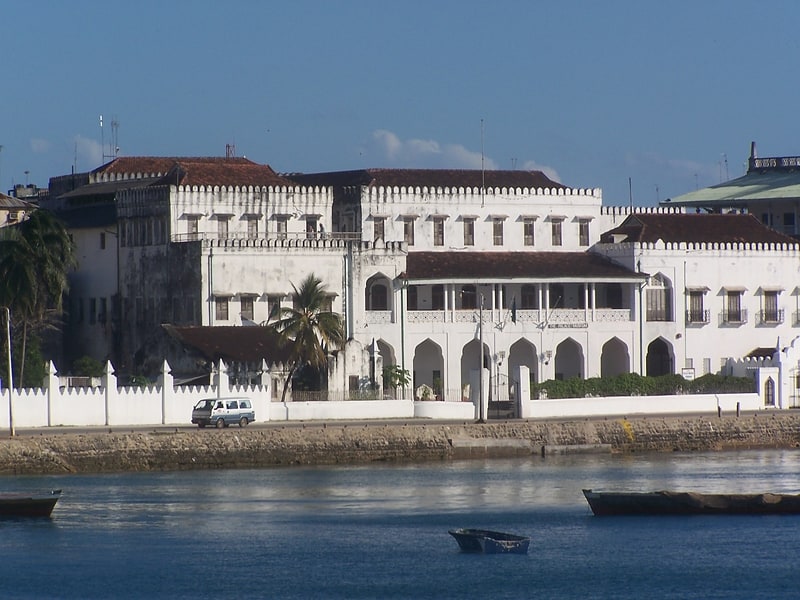
Museum in Zanzibar, Tanzania. The Sultan's Palace is one of the main historical buildings of Stone Town, Zanzibar, Tanzania. It is a 3-story building with merlon-decorated white walls, located in Mizingani Road, on the seafront, between the House of Wonders and the Old Dispensary.
It stands on the site of the previous palace, called Bait As-Sahel Arabic: بيت الساحل) that was destroyed in the Anglo Zanzibar war of 1896. The present palace was built in late 19th century to serve as a residence for the Sultan's family. After the Zanzibar Revolution, in 1964 it was formally renamed to People's Palace and used as a government seat. In 1994, it became a museum about the Zanzibari royal family and history.
One floor of the museum is dedicated to Sultan Khalifa bin Harub; another one to Sayyida Salme, best known as Emily Ruete, former Zanzibari princess who fled from the sultanate to relocate in Europe with her husband; the exhibits include some of her writings, clothes and daily life accessories. Several of the furniture items and other belongings to the sultan's family are in exhibition to give visitors an idea of how was the life in Zanzibar during the 19th century.[4]
Address: 831 Jamatini Rd, Stone Town
St. Joseph's Cathedral

Principal church in Zanzibar, Tanzania. The Roman Catholic cathedral of St. Joseph is one of the most important historical buildings in Stone Town, Zanzibar, as well as one of its main visitor attractions.
The church is regularly used by the local Catholic community, with several masses being held each Sunday and occasionally on weekdays.[5]
Christ Church

Also known as: Kanisa la Kristo Zanzibar
Cathedral in Zanzibar, Tanzania. Christ Church is an Anglican cathedral in Stone Town, Zanzibar, Tanzania. It belongs to the Anglican Church of Tanzania. It is a landmark historical church, as well as one of the most prominent examples of early Christian architecture in East Africa.
It was built in seven years, the foundation stone being laid on Christmas Day 1873 until the opening on Christmas 1879, based on a vision of Edward Steere, third Anglican bishop of Zanzibar, who actively contributed to the design. As most buildings in Stone Town, it is made mostly of coral stone. It has a unique concrete roof shaped in an unusual barrel vault (that was Steere's idea) and the overall structure mixes Perpendicular Gothic and Islamic details. The cathedral was consecrated in 1903 and named after Canterbury Cathedral.
The church is located in Mkunazini Road, in the centre of the old town, and occupies a large area where the biggest slave market of Zanzibar used to be; the construction of the cathedral was in fact intended to celebrate the end of slavery. The altar is said to be in the exact place where the main "whipping post" of the market used to be. In the square there is a well-known monument to the slaves (a few human figures in chains emerging from a pit) as well as a museum on slavery.
Edward Steere died of a heart attack when the cathedral was almost completed, and was buried behind the altar. Inside the church there is a cross that was made from the wood of the tree that grows on the place where David Livingstone's heart was buried, in Chitambo.
As many other historical coral-stone buildings in Stone Town, the Cathedral experiences decay and structural problems and needs restoring.
The cathedral is linked with Ely Cathedral, in the diocese of Ely, Cambridgeshire, UK.[6]
Address: Mkunazini, Zanzibar, Stone Town
Old Dispensary
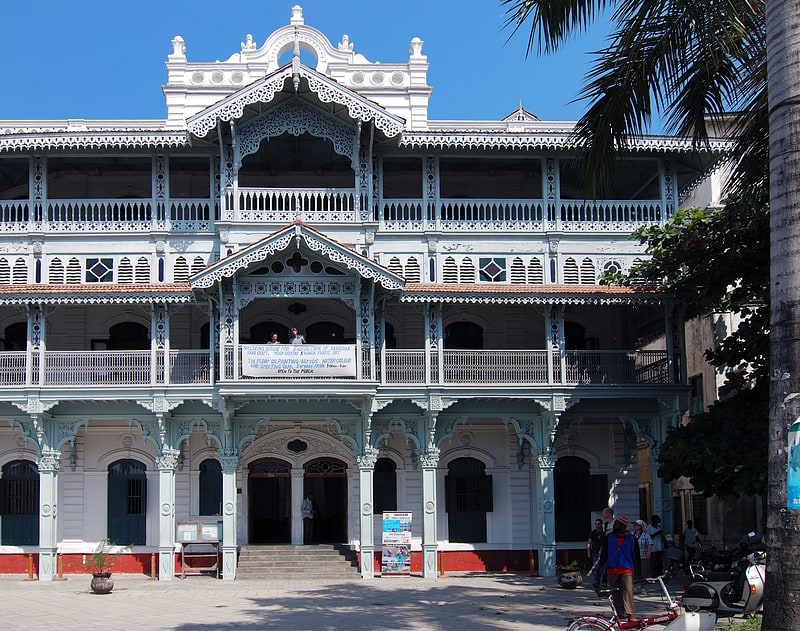
Historical landmark in Zanzibar, Tanzania. The Old Dispensary, also known as Ithnashiri Dispensary, is a historical building in Stone Town, Zanzibar. It is located on the seafront, in Mizingani Road, halfway between the Palace Museum and the harbour. It owes its name to the fact that it served as a dispensary in the first half of the 20th century.
The Dispensary is one of the most finely decorated buildings of Stone Town and a symbol of the multi-cultural architecture and heritage of the city. Its wooden carved balconies, with stained glass decorations, are of Indian influence; the main structure is built with traditional Zanzibari coral rag and limestone, but covered with stucco adornments of European neo-classical taste. The inside of the building is just as sophisticated, with a covered courtyard and carved bridges connecting the floors.
The Dispensary is one of Stone Town's major tourist attractions. It has a small museum about the history of Zanzibar.[7]
Hamamni Persian Baths

Tourist attraction in Zanzibar, Tanzania. The Hamamni Persian Baths is located in a historical building of Stone Town, Zanzibar. The name Hamamni is also used to refer to the neighbourhood where the building is located.
The Baths were built between 1870 and 1888 for sultan Barghash bin Said for use as public baths, and maintained this function until 1920. They are referred to as "Persian" because their construction was commissioned to Shirazi architects. The word "Hamamni" means "the place of the baths".
The building had a complex structure with several rooms, including hot and cold baths, toilets, shaving areas, and a restaurant. Hot water was provided by underground aqueducts. Entrance was subject to a fee, so that only wealthy zanzibaris could use them regularly. They were open both to men and women, but with different hours of admittance.
The Baths are not working anymore, but they are open to visitors and are a major tourist attractions of Stone Town. Visits are limited to some areas of the original complex because part of it (e.g. the restaurant) has since been adapted for private residences.[8]
Address: Hamamni Street, Stone Town
Malindi Mosque
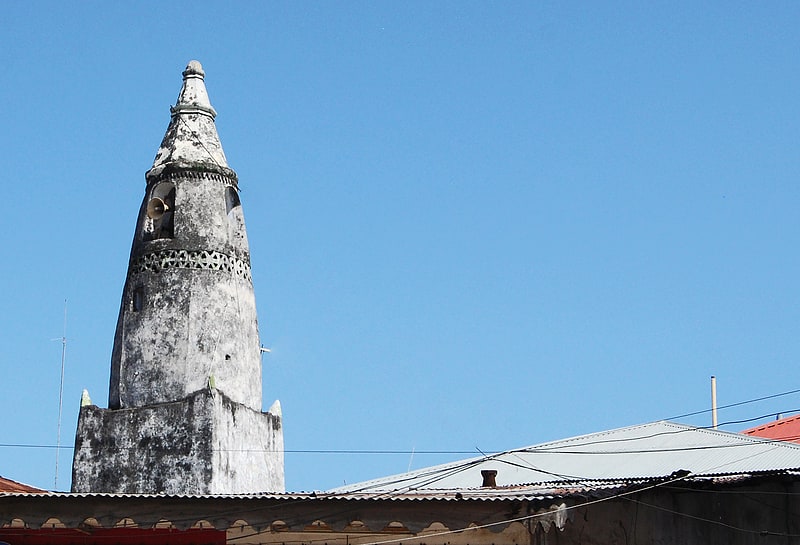
Mosque in Zanzibar, Tanzania. Malindi Mosque is a mosque in Stone Town, Zanzibar, Tanzania, located near the port. It stems from the 1830s but was possible built on the site of an elder mosque that might have dated back to the 17th century or earlier. Some travel guides claim an origin in the 15th century.
The present mosque was built in 1834-1835/1250 AH by Muhammad ben Abdulkadir al-Mansaby from the Benadir coast in Somalia. He was a rich merchant in Zanzibar during the 1820s to the 1840s. The building was enlarged twice in 1841 and 1890.
It has some unusual architectural features, including a cone-shaped minaret (one of just three minarets of this shape in East Africa) and a square platform.[9]
Tippu Tip's House

Building in Zanzibar, Tanzania. Tippu Tip's House is a historical building in Stone Town, Zanzibar, located in Suicide Alley in the Shangani ward near the Africa House Hotel and Serena Inn, about 15–25 minute walking time from the Old Fort and Forodhani Gardens. It is the house where the powerful merchant and slave trader Tippu Tip lived. The building was a private residence until the Zanzibar Revolution and was later converted into a block of flats.
Despite being a tourist attraction, it is not formally open to visitors, and it is in such a state of decay that it has been described as "the most magnificent squat in all of Africa". The large decorated carved wooden door, as well as the black and white marble steps, still testify the great wealth of the historical owner of the house.[10]
Ijumaa Mosque
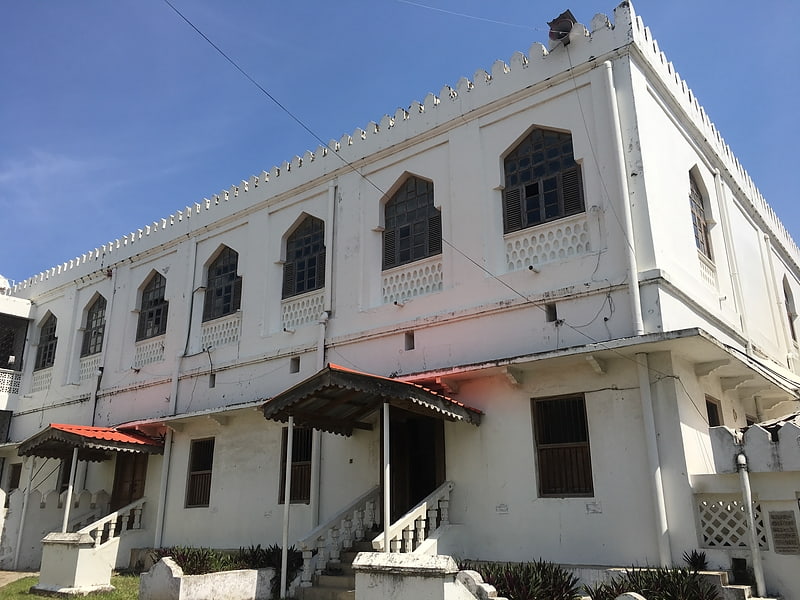
Mosque. Ijumaa Mosque is a mosque in Stone Town, Zanzibar, Tanzania. The mosque was completely renovated in 1994 in the modern arabesque style.[11]
Address: Mizingani Rd, Stone Town